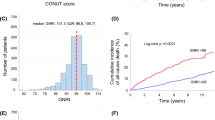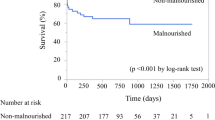Abstract
Background
Recently, malnutrition has been shown to be related to worse clinical outcomes in patients with heart failure. However, the association between nutritional status and clinical outcomes in patients with coronary artery disease (CAD) remains unclear. We investigated the prognostic value of malnutrition assessed by the Controlling Nutritional Status (CONUT; range 0–12, higher = worse, consisting of serum albumin, cholesterol and lymphocytes) score in patients with CAD.
Methods
The CONUT score was measured on admission in a total of 1987 patients with stable CAD who underwent elective percutaneous coronary intervention (PCI) between 2000 and 2011. Patients were divided into two groups according to their CONUT score (0–1 vs. ≥2). The incidence of major adverse cardiac events (MACE), including all-cause death and non-fatal myocardial infarction, was evaluated.
Results
The median CONUT score was 1 (interquartile range 0–2). During the median follow-up of 7.4 years, 342 MACE occurred (17.2%). Kaplan–Meier curves revealed that patients with high CONUT scores had higher rates of MACE (log-rank p < 0.0001). High CONUT scores showed a significant increase in the incidence of MACE compared with low CONUT scores, even after adjusting for confounding factors (hazard ratio: 1.64, 95% confidence interval 1.30–2.07, p < 0.0001). Adding CONUT scores to a baseline model with established risk factors improved the C-index (p = 0.02), net reclassification improvement (p = 0.004) and integrated discrimination improvement (p = 0.0003).
Conclusions
Nutritional status assessed by the CONUT score was significantly associated with long-term clinical outcomes in patients with CAD. Pre-PCI assessment of the CONUT score may provide useful prognostic information.



Similar content being viewed by others
References
Lew CC, Yandell R, Fraser RJ, Chua AP, Chong MF, Miller M (2016) Association between malnutrition and clinical outcomes in the intensive care unit: a systematic review. J Parenter Enteral Nutr. doi:10.1177/0148607115625638
Honda Y, Nagai T, Iwakami N, Sugano Y, Honda S, Okada A, Asaumi Y, Aiba T, Noguchi T, Kusano K, Ogawa H, Yasuda S, Anzai T, Na DEFI (2016) Usefulness of geriatric nutritional risk index for assessing nutritional status and its prognostic impact in patients aged ≥65 years with acute heart failure. Am J Cardiol 118(4):550–555. doi:10.1016/j.amjcard.2016.05.045
Kinugasa Y, Kato M, Sugihara S, Hirai M, Yamada K, Yanagihara K, Yamamoto K (2013) Geriatric nutritional risk index predicts functional dependency and mortality in patients with heart failure with preserved ejection fraction. Circ J 77(3):705–711
Luo H, Yang H, Huang B, Yuan D, Zhu J, Zhao J (2016) Geriatric nutritional risk index (GNRI) independently predicts amputation inchronic criticallimb ischemia (CLI). PLoS One 11(3):e0152111. doi:10.1371/journal.pone.0152111
Seo SH, Kim SE, Kang YK, Ryoo BY, Ryu MH, Jeong JH, Kang SS, Yang M, Lee JE, Sung MK (2016) Association of nutritional status-related indices and chemotherapy-induced adverse events in gastric cancer patients. BMC Cancer 16(1):900. doi:10.1186/s12885-016-2934-5
Takahashi H, Ito Y, Ishii H, Aoyama T, Kamoi D, Kasuga H, Yasuda K, Maruyama S, Matsuo S, Murohara T, Yuzawa Y (2014) Geriatric nutritional risk index accurately predicts cardiovascular mortality in incident hemodialysis patients. J Cardiol 64(1):32–36. doi:10.1016/j.jjcc.2013.10.018
Ignacio de Ulibarri J, Gonzalez-Madrono A, de Villar NG, Gonzalez P, Gonzalez B, Mancha A, Rodriguez F, Fernandez G (2005) CONUT: a tool for Controlling Nutritional Status. First validation in a hospital population. Nutr Hosp 20(1):38–45
Iwakami N, Nagai T, Furukawa TA, Sugano Y, Honda S, Okada A, Asaumi Y, Aiba T, Noguchi T, Kusano K, Ogawa H, Yasuda S, Anzai T, Na DEFI (2017) Prognostic value of malnutrition assessed by Controlling Nutritional Status score for long-term mortality in patients with acute heart failure. Int J Cardiol 230:529–536. doi:10.1016/j.ijcard.2016.12.064
Nochioka K, Sakata Y, Takahashi J, Miyata S, Miura M, Takada T, Fukumoto Y, Shiba N, Shimokawa H (2013) Prognostic impact of nutritional status in asymptomatic patients with cardiac diseases: a report from the CHART-2 Study. Circ J 77(9):2318–2326
Teramoto T, Sasaki J, Ishibashi S, Birou S, Daida H, Dohi S, Egusa G, Hiro T, Hirobe K, Iida M, Kihara S, Kinoshita M, Maruyama C, Ohta T, Okamura T, Yamashita S, Yokode M, Yokote K (2013) Diagnostic criteria for dyslipidemia. J Atheroscler Thromb 20(8):655–660
Matsuo S, Imai E, Horio M, Yasuda Y, Tomita K, Nitta K, Yamagata K, Tomino Y, Yokoyama H, Hishida A, Collaborators developing the Japanese equation for estimated GFR (2009) Revised equations for estimated GFR from serum creatinine in Japan. Am J Kidney Dis 53(6):982–992. doi:10.1053/j.ajkd.2008.12.034
Cabre M, Ferreiro C, Arus M, Roca M, Palomera E, Serra-Prat M (2015) Evaluation of CONUT for clinical malnutrition detection and short-term prognostic assessment in hospitalized elderly people. J Nutr Health Aging 19(7):729–733. doi:10.1007/s12603-015-0536-6
Iseki Y, Shibutani M, Maeda K, Nagahara H, Ohtani H, Sugano K, Ikeya T, Muguruma K, Tanaka H, Toyokawa T, Sakurai K, Hirakawa K (2015) Impact of the preoperative Controlling Nutritional Status (CONUT) score on the survival after curative surgery for colorectal cancer. PLoS One 10(7):e0132488. doi:10.1371/journal.pone.0132488
Toyokawa T, Kubo N, Tamura T, Sakurai K, Amano R, Tanaka H, Muguruma K, Yashiro M, Hirakawa K, Ohira M (2016) The pretreatment Controlling Nutritional Status (CONUT) score is an independent prognostic factor in patients with resectable thoracic esophageal squamous cell carcinoma: results from a retrospective study. BMC Cancer 16:722. doi:10.1186/s12885-016-2696-0
Agra Bermejo RM, Gonzalez Ferreiro R, Varela Roman A, Gomez Otero I, Kreidieh O, Conde Sabaris P, Rodriguez-Manero M, Moure Gonzalez M, Seoane Blanco A, Virgos Lamela A, Garcia Castelo A, Gonzalez Juanatey JR (2017) Nutritional status is related to heart failure severity and hospital readmissions in acute heart failure. Int J Cardiol 230:108–114. doi:10.1016/j.ijcard.2016.12.067
Basta G, Chatzianagnostou K, Paradossi U, Botto N, Del Turco S, Taddei A, Berti S, Mazzone A (2016) The prognostic impact of objective nutritional indices in elderly patients with ST-elevation myocardial infarction undergoing primary coronary intervention. Int J Cardiol 221:987–992. doi:10.1016/j.ijcard.2016.07.039
Kunimura A, Ishii H, Uetani T, Aoki T, Harada K, Hirayama K, Negishi Y, Shibata Y, Sumi T, Kawashima K, Tatami Y, Kawamiya T, Yamamoto D, Suzuki S, Amano T, Murohara T (2017) Impact of nutritional assessment and body mass index on cardiovascular outcomes in patients with stable coronary artery disease. Int J Cardiol 230:653–658. doi:10.1016/j.ijcard.2017.01.008
Kobayashi I, Ishimura E, Kato Y, Okuno S, Yamamoto T, Yamakawa T, Mori K, Inaba M, Nishizawa Y (2010) Geriatric Nutritional Risk Index, a simplified nutritional screening index, is a significant predictor of mortality in chronic dialysis patients. Nephrol Dial Transplant 25(10):3361–3365. doi:10.1093/ndt/gfq211
Guigoz Y, Vellas B, Garry PJ (1996) Assessing the nutritional status of the elderly: the mini nutritional assessment as part of the geriatric evaluation. Nutr Rev 54(1 Pt 2):S59–S65
Detsky AS, McLaughlin JR, Baker JP, Johnston N, Whittaker S, Mendelson RA, Jeejeebhoy KN (1987) What is subjective global assessment of nutritional status? J Parenter Enteral Nutr 11(1):8–13
Bouillanne O, Morineau G, Dupont C, Coulombel I, Vincent JP, Nicolis I, Benazeth S, Cynober L, Aussel C (2005) Geriatric Nutritional Risk Index: a new index for evaluating at-risk elderly medical patients. Am J Clin Nutr 82(4):777–783
Margarson MP, Soni N (1998) Serum albumin: touchstone or totem? Anaesthesia 53(8):789–803
von Haehling S, Doehner W, Anker SD (2007) Nutrition, metabolism, and the complex pathophysiology of cachexia in chronic heart failure. Cardiovasc Res 73(2):298–309. doi:10.1016/j.cardiores.2006.08.018
Ridker PM, Cushman M, Stampfer MJ, Tracy RP, Hennekens CH (1997) Inflammation, aspirin, and the risk of cardiovascular disease in apparently healthy men. N Engl J Med 336(14):973–979. doi:10.1056/nejm199704033361401
Ross R (1999) Atherosclerosis–an inflammatory disease. N Engl J Med 340(2):115–126. doi:10.1056/nejm199901143400207
Kim SB, Chi HS, Park JS, Hong CD, Yang WS (1999) Effect of increasing serum albumin on plasma D-dimer, von Willebrand factor, and platelet aggregation in CAPD patients. Am J Kidney Dis 33(2):312–317
Roche M, Rondeau P, Singh NR, Tarnus E, Bourdon E (2008) The antioxidant properties of serum albumin. FEBS Lett 582(13):1783–1787. doi:10.1016/j.febslet.2008.04.057
Turell L, Carballal S, Botti H, Radi R, Alvarez B (2009) Oxidation of the albumin thiol to sulfenic acid and its implications in the intravascular compartment. Braz J Med Biol Res 42(4):305–311
Horne BD, Anderson JL, John JM, Weaver A, Bair TL, Jensen KR, Renlund DG, Muhlestein JB (2005) Which white blood cell subtypes predict increased cardiovascular risk? J Am Coll Cardiol 45(10):1638–1643. doi:10.1016/j.jacc.2005.02.054
Ommen SR, Gibbons RJ, Hodge DO, Thomson SP (1997) Usefulness of the lymphocyte concentration as a prognostic marker in coronary artery disease. Am J Cardiol 79(6):812–814
Onsrud M, Thorsby E (1981) Influence of in vivo hydrocortisone on some human blood lymphocyte subpopulations. I. Effect on natural killer cell activity. Scand J Immunol 13(6):573–579
Horwich TB, Hamilton MA, Maclellan WR, Fonarow GC (2002) Low serum total cholesterol is associated with marked increase in mortality in advanced heart failure. J Cardiac Fail 8(4):216–224
Iseki K, Yamazato M, Tozawa M, Takishita S (2002) Hypocholesterolemia is a significant predictor of death in a cohort of chronic hemodialysis patients. Kidney Int 61(5):1887–1893. doi:10.1046/j.1523-1755.2002.00324.x
Volpato S, Zuliani G, Guralnik JM, Palmieri E, Fellin R (2001) The inverse association between age and cholesterol level among older patients: the role of poor health status. Gerontology 47(1):36–45. doi:10.1159/000052768
Stenvinkel P, Heimburger O, Paultre F, Diczfalusy U, Wang T, Berglund L, Jogestrand T (1999) Strong association between malnutrition, inflammation, and atherosclerosis in chronic renal failure. Kidney Int 55(5):1899–1911. doi:10.1046/j.1523-1755.1999.00422.x
Nakagomi A, Kohashi K, Morisawa T, Kosugi M, Endoh I, Kusama Y, Atarashi H, Shimizu W (2016) Nutritional status is associated with inflammation and predicts a poor outcome in patients with chronic heart failure. J Atheroscler Thromb 23(6):713–727. doi:10.5551/jat.31526
Bourdel-Marchasson I, Emeriau JP (2001) Nutritional strategy in the management of heart failure in adults. Am J Cardiovasc Drugs Drugs Dev Interv 1(5):363–373
Broqvist M, Arnqvist H, Dahlstrom U, Larsson J, Nylander E, Permert J (1994) Nutritional assessment and muscle energy metabolism in severe chronic congestive heart failure–effects of long-term dietary supplementation. Eur Heart J 15(12):1641–1650
Salzwedel A, Reibis R, Wegscheider K, Eichler S, Buhlert H, Kaminski S, Voller H (2016) Cardiopulmonary exercise testing is predictive of return to work in cardiac patients after multicomponent rehabilitation. Clin Res Cardiol 105(3):257–267. doi:10.1007/s00392-015-0917-1
Sze S, Zhang J, Pellicori P, Morgan D, Hoye A, Clark AL (2017) Prognostic value of simple frailty and malnutrition screening tools in patients with acute heart failure due to left ventricular systolic dysfunction. Clin Res Cardiol. doi:10.1007/s00392-017-1082-5
Acknowledgements
The authors are grateful to the staff of the Department of Cardiovascular Medicine at Juntendo University and the Department of Cardiology at Juntendo University Shizuoka Hospital. The authors also appreciate the secretarial assistance of Yumi Nozawa and Ayako Onodera.
Author information
Authors and Affiliations
Corresponding author
Ethics declarations
Funding
None.
Rights and permissions
About this article
Cite this article
Wada, H., Dohi, T., Miyauchi, K. et al. Prognostic impact of nutritional status assessed by the Controlling Nutritional Status score in patients with stable coronary artery disease undergoing percutaneous coronary intervention. Clin Res Cardiol 106, 875–883 (2017). https://doi.org/10.1007/s00392-017-1132-z
Received:
Accepted:
Published:
Issue Date:
DOI: https://doi.org/10.1007/s00392-017-1132-z




